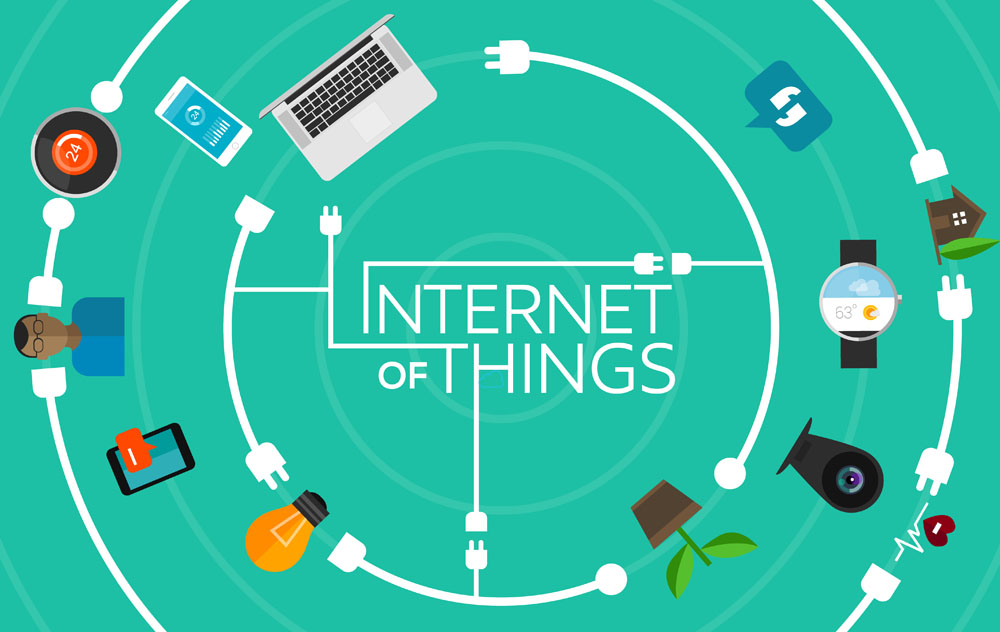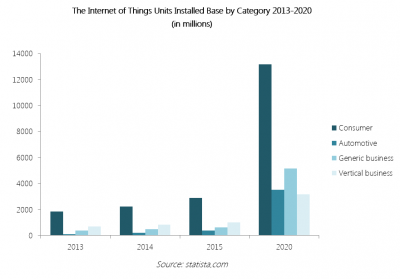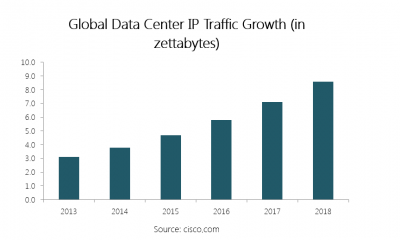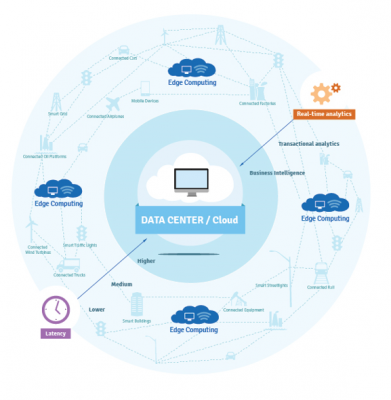
Whitepaper: Behind the Internet of Things – Hosting Industry in the Age of Connected Devices
Whitepaper by Crucial Research
March, 2015
Click here view the PDF whitepaper
-
Introduction
Parallel to the growth of the Internet, its underlying infrastructure is undergoing a transformation in order to meet the demand for fast and accurate information delivery. As the world goes mobile and smart devices become standard solutions for most personal and business computing operations, this demand keeps pushing the boundaries of modern technologies and the hosting industry in particular. Namely, the age of connected smart devices that nowadays include much more than phones, tablets and personal computers creates new challenges for traditional IT infrastructure and calls for innovative solutions.
With a growing number of home appliances, cars and wearable devices connected to the Internet, the world is entering a new technology phase marked by the acronym IoT. The Internet of Things, a commonly discussed technology trend, has already triggered new developments in the field of data processing and distribution technology, and started reshaping the global hosting industry. The increased usage of the Internet and various web-based apps creates an ecosystem where the speed of data transfer and constant information availability are some of the most important rules to live and work by. Coupled with the growth of other smart solutions that fall under the IoT category, such habits make data storage and transfer more complex activities to handle.
Unsurprisingly, in this hyper-connected world, traditional web technologies are being replaced by advanced solutions that are able to support constant information flow across multiple network points, locations and devices. For the hosting industry, this brings a set of changes regarding server infrastructure and data center technology whose role in enabling fast and accurate data transfer is certainly critical. Thus, in the wake of the Internet of Things, the primary task for the global hosting industry is to ensure consistent availability of smart solutions that can support performance and security requirements of the IoT units. Considering the latest statistics and predictions related to the growth of the trend, this white paper analyses the state of the hosting industry and examines the ways interconnected objects will further influence its development.
-
IoT: Definition and Growth Statistics
Potentially the most powerful tech trend the world has seen in decades has been a subject of all the burning tech discussions over the last few years. Coined by Kevin Ashton in 1999, the term Internet of Things today is commonly used to refer to the enormous number of devices or “things” connected to the Internet, which communicate with networks and servers via automated systems. More precisely, one of the most widely accepted definitions of IoT states that it stands for:
“A world where physical objects are seamlessly integrated into the information network, and where physical objects can become active participants in business processes. Services are available to interact with these ‘smart objects’ over the Internet, query, and change their state and any information associated with them.”
Although there are many ways to approach this concept, the above definition by Michael Kassner of TechRepublic emphasizes the most important types of data that today are generated on a regular basis. Considering the growth rate of this trend, it is clear that the world is facing the next data evolution. Correspondingly, many predictions and reports were made in relation to the extent to which IoT will grow in future. Current statistics for the IoT units installed in 2015 count 5 billion, while the estimated number of units for 2020 reaches five times as much. Unsurprisingly, the greatest number of units falls under the consumer category, meaning that personal devices constitute the greatest portion of these units.

As illustrated on the graphic above, in the next five years, the tech industry will witness a tremendous growth of the number of objects connected to the web. While consumer devices will remain the most dominant units in the IoT system, those that fall under the automotive category will have the highest growth rate in the following period. This means that cars of the near future will be able to store greater amounts of personal data in order to facilitate our daily lives. In fact, considering the number of such units installed in 2014 and 2015, these systems have already become a part of our everyday reality. Some regions, however, may be lagging in terms of adopting these technologies, but the fact is that the world is rapidly moving towards IoT.
Currently, Asian and North American countries are leading the transition to smart buildings and smart cities, while the rest of the world is yet to join the trend. Of course, the overall impact IoT will have in the next few years will range by industries, as well as by countries, but most fields are already preparing for it. This is the case with the global hosting industry, which is seeing a rapid growth reflected in the expansion of data centers and development of new hosting solutions intended to enable smooth IoT implementations across industries.
-
Data center in the IoT age
Being the backbone of web technologies, the data center industry is directly affected by the growth of the Internet of Things. As this technology expands globally, greater amounts of storage and network capacity are needed to handle massive amounts of data transmitted through different networks and devices. With cars, furniture, home appliances and electric grids communicating with networks and servers, more storage space and computing power is required to collect and analyze such pieces of information. This is why data centers are becoming bigger and more powerful, as suggested by the latest market reports.
2.1. Global data center growth
| Data center construction to grow by 22% over the next few years |
Resulting from the increase in the demand for storage and network capacities, a great expansion is ahead of traditional data centers. Global Data Center Construction Market 2014-2018 research by Research and Markets suggests that data center construction will increase by 22% over the next few years, which is partly influenced by IoT. Furthermore, Christian Belady from Global Foundation Services predicts that by 2020, global data center markets will grow by 50% or to $78 billion. As he points out, this will be driven primarily by the increased demand for cloud solutions and SaaS, which already represent commonly used resources in companies both large and small.
Furthermore, Cisco Global Cloud Index predicts that by 2018, global data centre IP traffic is expected to grow at a CAGR of 23%, which will partly be driven by the rise of IoT.

Similarly, the report suggests that 78% of workloads will be processed by cloud data centers, while the remaining 22% will be handled by traditional data centers. Therefore, an important role in this growth will be played by cloud hosting, which is a technology sufficiently powerful to support the needs of IoT and associated data generation growth.
2.2. Cloud hosting and the ‘edge’
| 90% of all IoT data will be hosted on cloud servers |
As a platform able to handle loads of complex, unstructured data traditional forms of server infrastructure are unable to cope with, the cloud is tightly connected to the growth of IoT. Over the last few years, the potential of cloud computing to handle the possible data transfer and processing issues has been widely celebrated, which is why its role in the growth of the trend is of essential significance. In fact, the cloud is expected to eventually become the place where most IoT data is stored, as suggested in a recent report by IDC. Namely, the report titled FutureScape: Worldwide Internet of Things Predictions for 2015 predicts that 90% of all IoT data will be hosted on cloud servers, since this technology greatly reduces the complexities of “data blending”.
However, it is not only the server itself that would play a role in handling IoT requests, but the “edge” of the network as well. As the number of data access points and devices increases, the edge becomes an increasingly important notion whose main role is to determine the most suitable data collection and delivery points so as not to cause latency that may come as a result of sending all the data directly to cloud servers.

While IoT data is stored and processed on cloud and remote servers, the edges are intended to enable analytics generation so that companies can properly use such data for business purposes. The view of the edge as an essential part in putting IoT data into practice has been promoted by Cisco for few years now, most frequently in relation to fog computing, a paradigm that is able to accurately capture and process IoT data thanks to its wide geographical distribution.
The cloud, on the other hand, has already made a revolution in the hosting industry by introducing powerful server technologies that can store and process huge amounts of data however complex they may be. Distributed globally, cloud servers are also able to deliver data across the network edges and minimize potential latencies. Combined with other innovative solutions such as fog, the cloud is justifiably seen as a backbone of IoT and all the associated hosting technologies. However, even though the cloud has long passed its infancy phase, the global hosting industry is still expected to face different challenges. For it is not only storage space that may become a problem as IoT expands, but also implementation of different solutions on the level of both enterprise and data center
-
Transformation challenges
As the demand for server capacity grows, data center and hosting providers need to keep the pace with the changes in order to create new, smarter ways to handle the traffic coming from all the different sources. Some experts suggest that the problems may be reflected in the extended load time of web pages due to capacity overload, which can bring multiple problems for smooth online communication and collaboration. However, these are the issues that can be solved on the level of an individual hosting or managed services provider, as opposed to some larger implementation challenges in specific industries. Certainly, given the fact that IoT is expected to include 26 billion units by 2020 (according to Gartner), data center and hosting industry will be expected to grow as well. In relation to this, Fabrizio Biscotti, research director at Gartner states:
“IoT deployments will generate large quantities of data that need to be processed and analyzed in real time. Processing large quantities of IoT data in real time will increase as a proportion of workloads of data centers, leaving providers facing new security, capacity and analytics challenges.”
The report is also significant as it identifies key challenges the magnitude of network connections associated with the IoT could bring. Unsurprisingly, most of the issues are related to managing security and privacy, which are already important issues in cloud hosting. Apart from these, managing IoT data may also yield challenges for CIOs, who will have additional IT infrastructure decisions to make.
- Enterprise security and data analytics
- Consumer privacy as users’ personal devices start transmitting more data
- Data generation (consumer-driven and enterprise-driven)
- Storage capacity management in enterprise
- Server technologies
- Data center network
These may be seen as the top challenges that drive hosting and data center providers to continue to build solutions that integrate all the security and performance features necessary to support IoT data. In terms of managing IT architecture within individual companies, however, IoT will pose even more challenges in terms of storage, network and security management. As suggested by Gartner,such challenges will require data center vendors to re-think infrastructure and create appropriate offerings for platform management. CIOs, on the other hand may need to plan integrating additional capacities to their IT infrastructure, which will additionally drive adoption of cloud hosting and virtualization solutions.
-
Implications for the hosting industry
Considering the digits associated with the IoT growth, web-enabled consumer and employee devices, as well as all the other objects connected to the Internet are to mark a new era in the enterprise system. With such a large number of data sources to analyze for the purpose of improving critical business processes, companies may start seeking to expand their own server capabilities or turning to managed service providers to handle the IoT implementations for them. Thus, this is yet another aspect of the IoT growth that will have a significant effect on the hosting industry. This topic was addressed back in 2012 by Rachel Chalmers, who pointed out that IoT will lead to an inflection point that will further emphasize the importance of cloud and managed services.
“Every single (enterprise) is in the process of redefining themselves as an information company. We believe hosting and managed services providers stand to be the main beneficiaries of this trend.”
On this occasion, Chalmers also explained that on-premise infrastructure will remain dominant in companies, but that it will be largely augmented by cloud resources. Such a hybrid environment will become a common resource in IoT-enabled companies thanks to its ability to combine multiple performance and security features. Of course, businesses will remain in need of advanced hosting solutions to help them maintain the sufficient level of server, storage and network resources.
-
Conclusions
As presented above, IoT is growing perhaps too rapidly for all the industries to keep pace with it, and this is one of the things that make it such an important trend for the hosting industry. To support all the new types of network connections and devices that request information from web and cloud servers, hosting providers need to be ready for some large-scale changes. Data centers are seeing accelerated growth, while backend technologies keep improving to suit the needs of the modern era. Therefore, it is easy to see why the global hosting industry is expected to boom in the next several years, along with associated challenges and opportunities the emerging trend will bring.
About Crucial
Crucial Hosting is an Australian-based company that offers reliable hosting solutions with an aim of helping small businesses in Australia improve their online presence. Founded in 2003, Crucial today is trusted by thousands of successful Australian businesses and partners with numerous global companies to deliver top-quality services. Focused on constant innovation and service improvement, Crucial is one of the industry leaders in the region.
Resources
Attaining IoT Value: How to Move from Connecting Things to Capturing Insights. Cisco.
Cisco Global Cloud Index: Forecast and Methodology, 2013 – 2018. Cisco.
Gartner Says the Internet of Things will Transform the Data Center. Gartner.
http://www.gartner.com/newsroom/id/2684616
Global Data Center Construction Market 2014-2018. Research and Markets.
http://www.researchandmarkets.com/research/kd4dk5/global_data
How Big is the Datacenter Construction Business. Microsoft Datacenters Blog.
IoT units installed base by category from 2013 to 2020. Statista.
http://www.statista.com/statistics/370350/internet-of-things-installed-base-by-category/
The Internet of Things: A Boom for Hosting. Data Center Knowledge.
http://www.datacenterknowledge.com/archives/2012/09/20/the-internet-of-things-a-boom-for-hosting/
The Internet of Things Business Index. ARM.
http://www.arm.com/files/pdf/eiu_internet_business_index_web.pdf
Worldwide Internet of Things Predictions for 2015. IDC.
http://www.idc.com/getdoc.jsp?containerId=prUS25291514
Why Experts are Nervous about the Internet of Things. TechRepublic.
http://www.techrepublic.com/article/why-experts-are-nervous-about-the-internet-of-things/
